Brother MFC-J450DW, MFC-J470DW, MFC-J475DW Quick Setup Guide
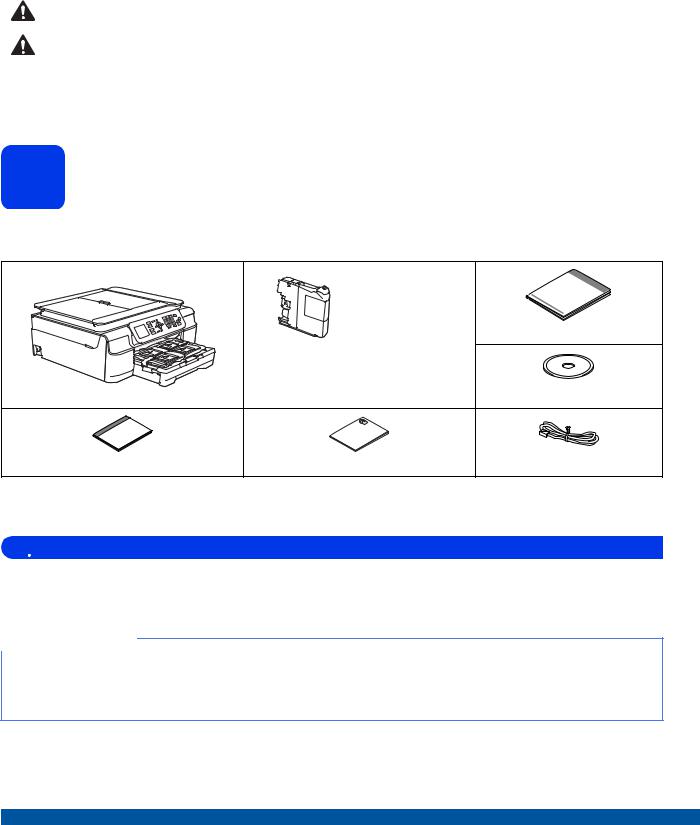
Quick Setup Guide |
MFC-J450DW |
Start Here |
MFC-J470DW |
|
|
|
MFC-J475DW |
|
|
Thank you for choosing Brother, your support is important to us and we value your business. Your Brother product is engineered and manufactured to the highest standards to deliver reliable performance, day-in and day-out.
Please read the Product Safety Guide first before you set up your machine. Then, please read this Quick Setup Guide for the correct setup and installation.
Manuals in Spanish for this model are available on the enclosed CD-ROM. Manuales en Español para este modelo están disponibles en el CD-ROM incluido.
WARNING |
WARNING indicates a potentially hazardous situation which, if not avoided, could result in death |
or serious injuries. |
|
|
|
CAUTION |
CAUTION indicates a potentially hazardous situation which, if not avoided, may result in minor |
or moderate injuries. |
|
|
|
IMPORTANT |
IMPORTANT indicates a potentially hazardous situation which, if not avoided, may result in |
damage to property or loss of product functionality. |
|
|
|
NOTE |
Notes tell you how to respond to a situation that may arise or give tips about how the operation |
works with other features. |
|
|
|
1 Unpack the machine and check the components
Most of the illustrations in this Quick Setup Guide show the MFC-J470DW.
The components included in the box may differ depending on your country.
Black |
|
Yellow |
|
Cyan |
|
Magenta |
Quick Setup Guide |
|
|
Starter Ink |
|
Cartridges |
|
|
CD-ROM 1 |
Basic User’s Guide |
Product Safety Guide |
Telephone Line Cord |
1If your computer does not have a CD-ROM drive, you can download the drivers from your model’s download page at http://solutions.brother.com/. For more information, see page 13.
 WARNING
WARNING
Plastic bags are used in the packing of your machine. Plastic bags are not toys. To avoid the danger of suffocation, keep these bags away from babies and children and dispose of them correctly.
NOTE
Save all packing materials and the box in case for any reason you must ship your machine.
USB cable
You need to purchase the correct USB cable.
We recommend using a USB 2.0 cable (Type A/B) that is no more than six feet (two meters) long.
USA/CAN Version 0
1
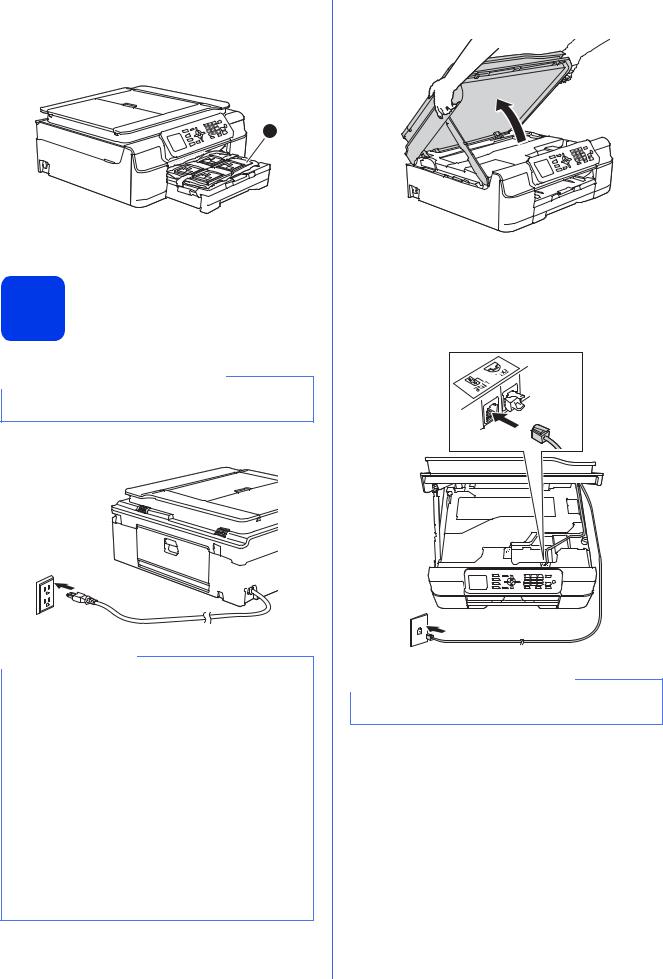
a Remove the protective tape and film covering the machine, and also from the LCD.
b Remove the plastic bag a containing the ink cartridges from on top of the paper tray.
1
c Make sure you have all the components.
2 |
Connect the power cord |
|
and telephone line |
IMPORTANT
DO NOT connect the USB cable yet (if you are using a USB cable).
a Connect the power cord.
NOTE
•If you do not plan to use the fax feature on this machine, go to step 3 on page 4.
•To prolong the life of the print head, provide the best ink cartridge economy and maintain print quality, we do not recommend unplugging the machine frequently and/or leaving the machine unplugged for extended periods of time. Each time you plug the machine in, it automatically cleans the print heads, which uses some of your ink.
We recommend using  to power down the
to power down the
machine. Using  allows minimal power to the machine, resulting in periodic, but less frequent, cleaning of the print heads.
allows minimal power to the machine, resulting in periodic, but less frequent, cleaning of the print heads.
2
b Lift the scanner cover until it locks securely into the open position.
c Connect the telephone line cord.
Connect one end of the telephone line cord to the jack marked LINE on the machine. Carefully guide the telephone line cord into the cable channel and out the back of the machine. Connect the other end to a modular wall jack.
IMPORTANT
The telephone line cord MUST be connected to the jack marked LINE on the machine.
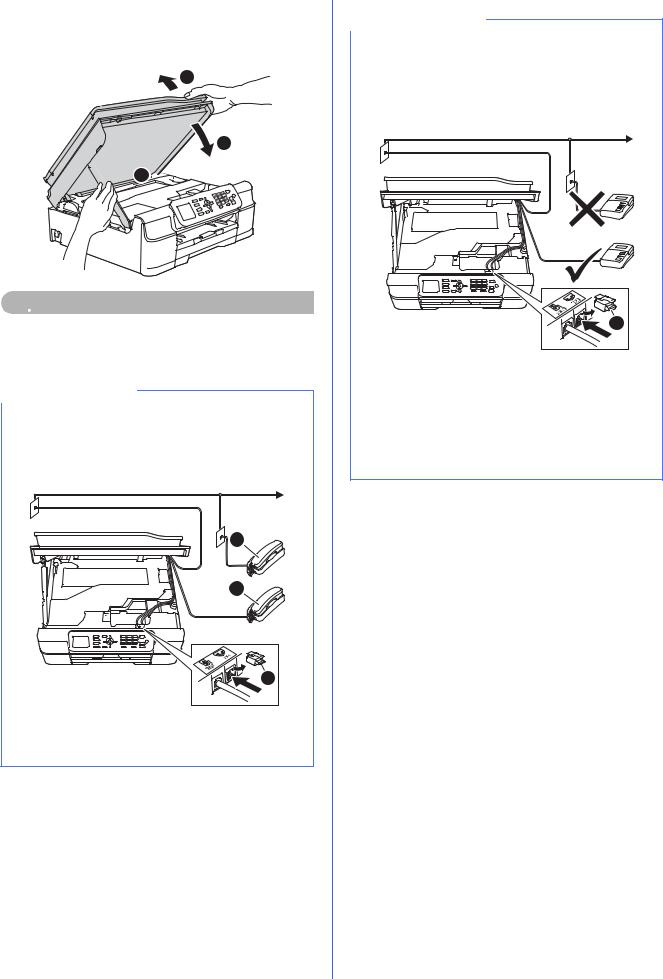
d Lift the scanner cover to release the lock a. Gently push the scanner cover support
down b and close the scanner cover c using both hands.
 3
3

 2
2



 CAUTION
CAUTION
Be careful not to pinch your fingers when the scanner cover closes.
NOTE
If you are sharing one telephone line with an external telephone, connect it as shown below.
Before you connect the external telephone, remove the white protective cap c from the EXT. jack on the machine.
1
2
3
aExtension telephone
bExternal telephone
cProtective cap
NOTE
If you are sharing one telephone line with an external telephone answering machine, connect it as shown below.
Before you connect the external telephone answering machine, remove the white protective cap a from the EXT. jack on the machine.
1
a Protective cap
Set the receive mode to External TAD if you have an external answering machine. See
Choose the correct Receive Mode on page 10. For additional details, see Connecting an external TAD (telephone answering device) in chapter 6 of the Basic User’s Guide.
3
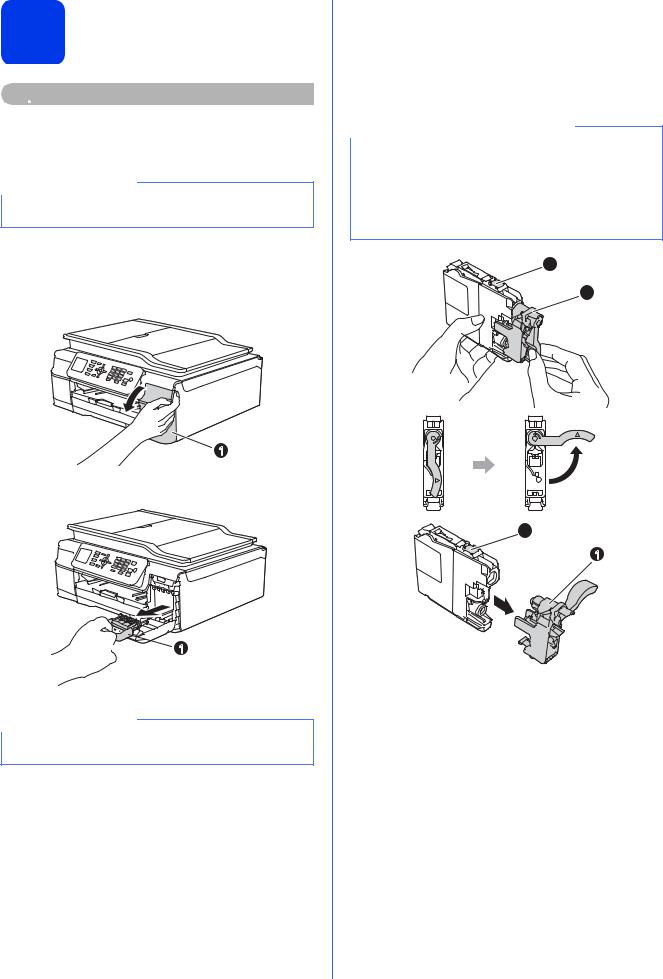
3 |
Install the ink cartridges |
 CAUTION
CAUTION
If ink gets in your eyes, wash it out with water at once and call a doctor if you are concerned.
NOTE
Make sure you install the Starter Ink Cartridges included with your machine first.
a Make sure that the power is turned on. The LCD will show No Ink Cartridge.
b Open the ink cartridge cover a.
1
c Remove the orange protective part a.
 1
1
NOTE
Do not throw away the orange protective part. You will need it if you transport the machine.
4
d Unpack the ink cartridge.
Turn the green release lever on the orange protective packing a counterclockwise until it clicks to release the vacuum seal. Then remove the orange protective packing a as shown.
IMPORTANT
•DO NOT shake the ink cartridges. If ink stains your skin or clothing, wash with soap or detergent at once.
•DO NOT touch the cartridge in the area indicated b, as this can cause the machine not to function with the cartridge.
2
1
2
1

e Take care to match the sticker color a with the cartridge color b as shown in the diagram below.
Install each ink cartridge in the direction of the arrow on the label.
1
2
f Gently push the back of the ink cartridge marked “PUSH” until it latches. After all the ink cartridges are installed, close the ink cartridge cover.
NOTE
The machine will prepare the ink tube system for printing. This process will take approximately four minutes. Do not turn off the machine. We recommend you perform the next step while waiting.
IMPORTANT
•DO NOT take out ink cartridges if you do not need to replace them. If you do so, it may reduce the ink quantity and the machine will not know the quantity of ink left in the cartridge.
•DO NOT repeatedly insert and remove the cartridges. If you do so, ink may seep out of the cartridge.
•Once you open an ink cartridge, install it in the machine and use it up within six months of installation. Use unopened ink cartridges by the expiration date written on the cartridge package.
•DO NOT dismantle or tamper with the ink cartridge, this can cause the ink to leak out of the cartridge.
•Brother strongly recommends that you do not refill the ink cartridges provided with your machine. We also strongly recommend that you continue to use only Genuine Brother Brand replacement ink cartridges. Use or attempted use of potentially incompatible ink and/or cartridges in the Brother machine may cause damage to the machine and/or may result in unsatisfactory print quality. Our warranty coverage does not apply to any problem that is caused by the use of unauthorized third party ink and/or cartridges. To protect your investment and obtain premium performance from the Brother machine, we strongly recommend the use of Genuine Brother Supplies.
5

4 |
Load plain Letter/A4 |
|
paper |
a Pull the paper tray a completely out of the machine.
1
b Open the output paper tray cover a.
1
6
c Gently press and slide the paper width guides aand then the paper length guide bto fit the paper size.
Make sure that the triangular marks c on the paper width guides a and paper length guide bline up with the mark for the paper size you are using.
NOTE
Make sure the first printed page is Letter/A4 size.
1



 3
3
 2
2
3
d Fan the stack of paper well to avoid paper jams and misfeeds.
NOTE
Always make sure that the paper is not curled or wrinkled.
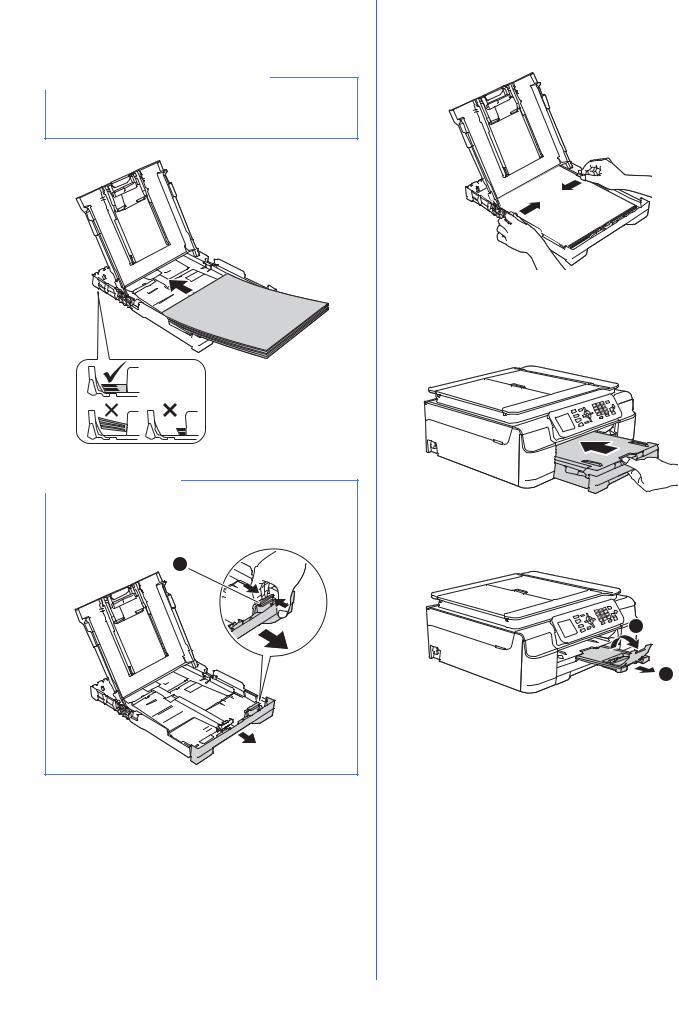
e Gently put the paper into the paper tray print side down and top edge first. Check that the paper is flat in the tray.
IMPORTANT
Be careful that you do not push the paper in too far; it may lift at the back of the tray and cause paper feed problems.
NOTE
When you use Legal size paper, press and hold the universal guide release button a as you slide out the front of the paper tray.
1
f Gently adjust the paper width guides to the paper with both hands. Make sure that the paper width guides touch the edges of the paper.
g Close the output paper tray cover.
h Slowly push the paper tray completely into the machine.
i While holding the paper tray in place, pull out the paper support a until it clicks, and then unfold the paper support flap b.
2
1
7

5 Check the print quality
a When the preparation process has finished, the LCD shows Load Paper and Press Color Start.
Press Color Start.
b Check the quality of the four color blocks on the sheet. (black/yellow/cyan/magenta)
c If all lines are clear and visible, press 1 (Yes) to finish the quality check and go to the next step.
OK
If lines are missing, press 2 (No) and follow the steps on the LCD.
Poor
6 Set the date and time
The LCD displays the date and time. You can also add the current date and time to each fax you send by setting your Station ID (see step 10).
a Enter the last two digits of the year on the dial pad, and then press OK.
(e.g. Enter 1 3 for 2013.)
8
b Enter the two digits for the month on the dial pad, and then press OK.
c Enter the two digits for the day on the dial pad, and then press OK.
d Press a or b to choose 12h Clock or 24h Clock, and then press OK.
e Enter the time on the dial pad, and then press
OK.
f (12h Clock only)
Press a or b to choose AM or PM, and then press OK.
NOTE
You can change date, time, or clock type (12h or 24h) at any time. For more information, see
Setting the date and time in the Basic User’s Guide.
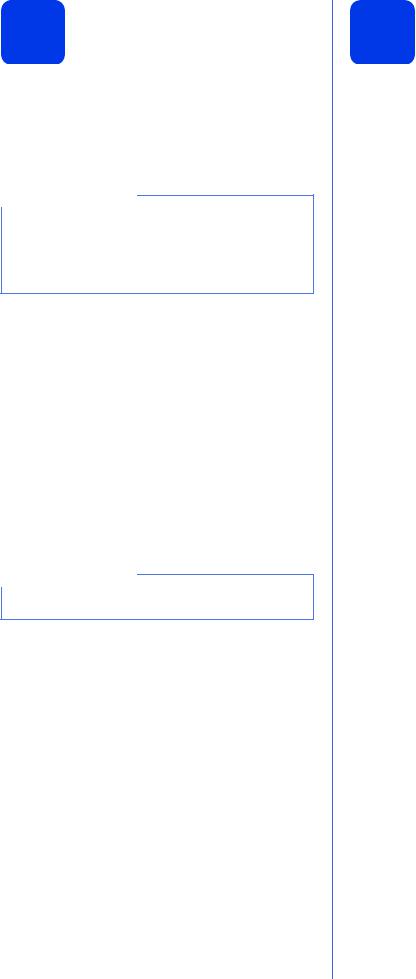
7 |
Wireless setup |
|
(if needed) |
When the Wi-Fi setup will start. message appears on the LCD, read the message, and then press OK to continue.
For wireless setup using a mobile device, go to a. For Windows® and Macintosh users, go to b.
NOTE
If you want to configure any of the options in steps 8-14, you can choose No in step a, and then go to step 8.
You will be able to configure the wireless settings later.
a Press a or b to choose Yes. Press OK.
Go to step 16 on page 20 to continue with the wireless setup.
After finishing the wireless setup, return to step 8 to finish the machine setup.
b Press a or b to choose No. Press OK.
Go to step 8 and continue with the machine setup.
Wireless setup instructions for Windows® and Macintosh users will be covered later, starting on page 20.
NOTE
If a prompt message appears on the LCD, read it and press OK to continue.
8 |
Choose your language |
|
(if needed) |
a Press Menu.
b Press a or b to choose Initial Setup. Press OK.
c Press a or b to choose Local Language. Press OK.
d Press a or b to choose your language. Press OK.
e Press Stop/Exit.
9

9 Choose the correct Receive Mode
The correct Receive Mode is determined by the external devices and telephone subscriber services (Voice Mail, Distinctive Ring, etc.) you have (or will be using) on the same line as the Brother machine.
For more information, see Using Receive Modes in chapter 5 of the Basic User’s Guide. If you are not using this machine for faxing, go to the next step.
Will you be using a Distinctive Ring number for receiving faxes?
Brother uses the term “Distinctive Ring” but telephone companies may have other names for this service such as Custom Ringing, RingMaster, Personalized Ring, Teen Ring, Ident-A-Call, and Smart Ring. See Distinctive Ring in chapter 6 of the Basic User’s Guide for instruction on setting up your machine using this feature.
Will you be using Voicemail on the same telephone line as your Brother machine?
If you have Voice Mail on the same telephone line as your Brother machine, there is a strong possibility that Voice Mail and the Brother machine will conflict with each other when receiving incoming calls. See Voice Mail in chapter 6 of the Basic User’s Guide for instructions on setting up your machine using this service.
Will you be using a Telephone Answering Device on the same telephone line as your Brother machine?
Your external telephone answering device (TAD) will automatically answer every call. Voice messages are stored on the external TAD and fax messages are printed. Choose External TAD as your receive mode. See the instructions below. For additional details, see Connecting an external TAD (telephone answering device) in chapter 6 of the Basic User’s Guide.
Will you be using your Brother machine on a dedicated fax line?
Your machine automatically answers every call as a fax. Choose Fax Only as your receive mode. See the instructions below.
Will you be using your Brother machine on the same line as your telephone?
Do you want to receive voice calls and faxes automatically?
The Fax/Tel receive mode is used when sharing the Brother machine and your telephone on the same line. Choose Fax/Tel as your receive mode. See the instructions below. For additional information see Fax/Tel in chapter 5 of the Basic User’s Guide for instructions on setting up and using this receive mode. Important Note: You cannot receive voice messages on either Voice Mail or an answering machine when choosing the Fax/Tel mode.
Do you expect to receive very few faxes?
Choose Manual as your receive mode. You control the phone line and must answer every call yourself. See the instructions below.
a Press Menu.
b Press a or b to choose Fax. Press OK.
c Press a or b to choose Setup Receive. Press OK. d Press a or b to choose Receive Mode. Press OK. e Press your preferred receive mode. Press OK.
f Press Stop/Exit.
NOTE
If the Receive Mode option is not displayed, make sure the Distinctive Ring feature is set to Off. (See Turning off Distinctive Ring in chapter 6 of the Basic User’s Guide.)
10

10 Set your Station ID
Set your machine’s Station ID so that the date and time appear on each fax you send.
If you are not using this machine for faxing, go to the next step.
a Press Menu.
b Press a or b to choose Initial Setup. Press OK.
c Press a or b to choose Station ID. Press OK.
d Enter your fax number (up to 20 digits) on the dial pad, and then press OK.
e Enter your name (up to 20 characters) using the dial pad, and then press OK.
NOTE
•See the following chart for entering your name.
•If you need to enter a character that is on the same key as the character before, press c to move the cursor to the right.
•If you entered a character incorrectly and want to change it, press d or c to move the cursor to the incorrect character, and then press Clear.
•For more information, see Entering Text in the
Basic User’s Guide.
Press |
One |
Two |
Three |
Four |
Five |
key |
time |
times |
times |
times |
times |
|
|
|
|
|
|
2 |
A |
B |
C |
2 |
A |
|
|
|
|
|
|
3 |
D |
E |
F |
3 |
D |
|
|
|
|
|
|
4 |
G |
H |
I |
4 |
G |
|
|
|
|
|
|
5 |
J |
K |
L |
5 |
J |
|
|
|
|
|
|
6 |
M |
N |
O |
6 |
M |
|
|
|
|
|
|
7 |
P |
Q |
R |
S |
7 |
|
|
|
|
|
|
8 |
T |
U |
V |
8 |
T |
|
|
|
|
|
|
9 |
W |
X |
Y |
Z |
9 |
|
|
|
|
|
|
f Press Stop/Exit.
NOTE
If you make a mistake and want to start again, press Stop/Exit and go back to a.
NOTE
(USA only)
The Telephone Consumer Protection Act of 1991 makes it unlawful for any person to use a computer or electronic device to send any message via a telephone fax machine unless such messages clearly contain, in a margin at the top or bottom of each transmitted page, or on the first page of the transmission, the date and time it is sent and an identification of the business or other entity or other individual sending the message and the telephone number of the sending machines or such business, other entity or individual.
11 Transmission
Verification Report
Your Brother machine is equipped with a Transmission Verification Report that can be used as confirmation that you sent a fax. This report lists the name or fax number of the receiving party, the date, time, and duration of the transmission, the number of pages transmitted, and whether or not the transmission was successful. If you want to use the Fax Transmission Report feature, see Transmission Verification Report in chapter 4 of the Basic User’s Guide.
11
